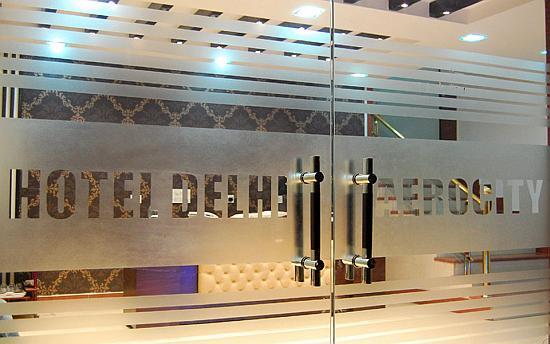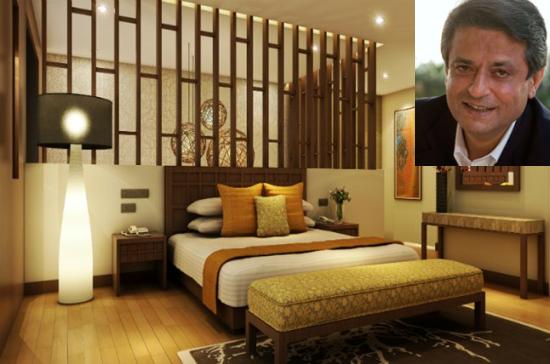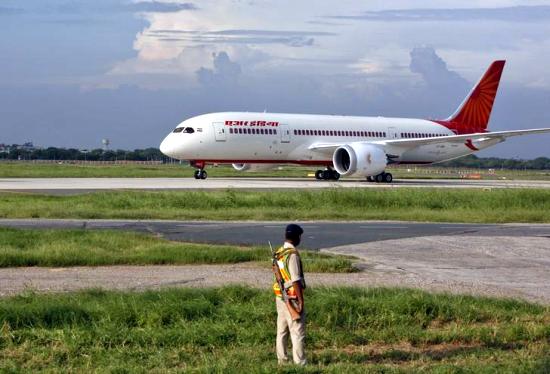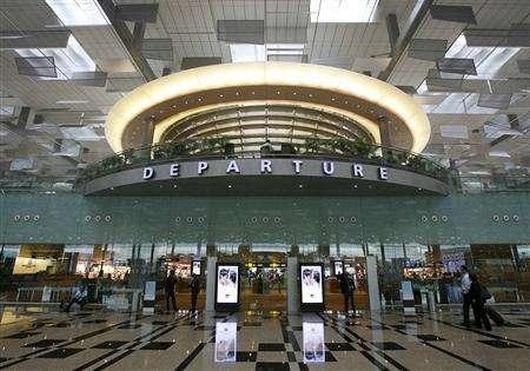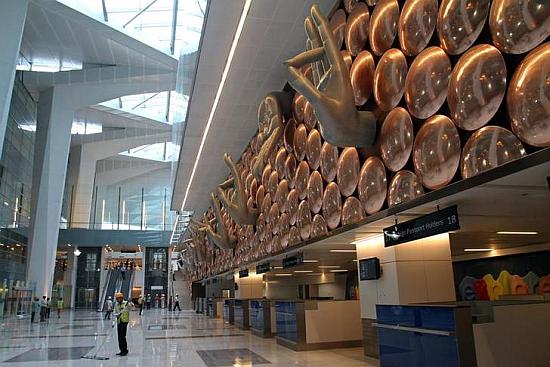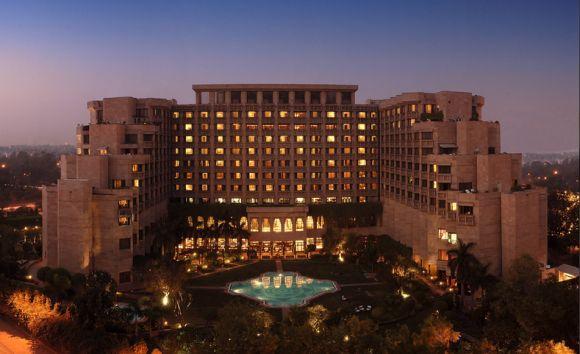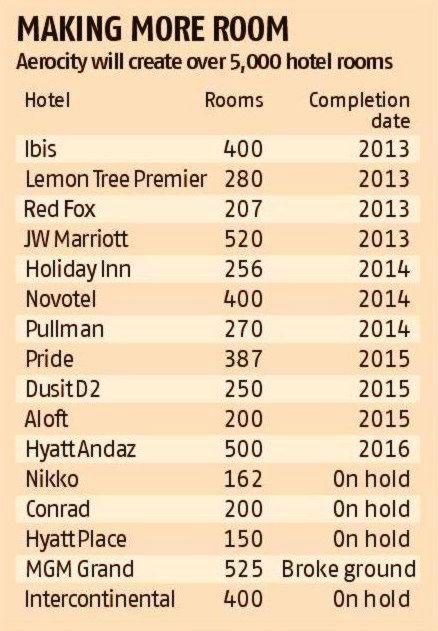 | « Back to article | Print this article |
Why Delhi Aerotropolis does not measure up to Beijing's
About a week ago, a mid-level police officer walked up to the Lemon Tree hotel in New Delhi's Aerocity, the sprawling hotel and commercial complex at the Indira Gandhi Airport, and asked the hotel authorities to put up bulletproof glass on all it windows.
The hotel, he said, overlooks the runway and is, therefore, a serious security threat. That bulletproof glass is meant to protect people inside and not outside didn't bother him.
That it could mean a lot of extra cost and throw the business calculations of the hotel out of gear too didn't bother him.
For Aerocity hoteliers, such suggestions have become routine ever since the local authorities "woke up" to the security challenge.
Some of the other solutions offered include knocking off two floors of the hotels, blocking the windows with concrete and building tall boundary walls so that the runway is no longer visible from any hotel in Aerocity.
Ever since Delhi Police raised the red flag in 2011, authorities ranging from the Union home ministry and the Bureau of Civil Aviation Security to the Intelligence Bureau have all become very wary of what is India's first such initiative in the hospitality sector.
Click NEXT to read more...
Why Delhi Aerotropolis does not measure up to Beijing's
For the hoteliers, this is bad news. "The government has become dysfunctional. The masterplan (for Aerocity) was cleared by the government. Suddenly, it wakes up to this new problem. It is complete lack of coordination between the various government bodies," says Patu Keswani, chairman and managing director, Lemon Tree Hotels.
Aerocity was a part of the modernisation plan drawn up by the GMR-led Delhi International Airport, or DIAL, which was approved by the civil aviation ministry.
After the rash of hotels that came up for the 1982 Asian Games, this was the biggest addition to the inventory of hotels in the city: 5,100 rooms.
Land was allotted to the developers in 2007 and construction began in 2008. From 2011, the Delhi Police started raising objections on security grounds. But why three years after construction commenced?
One argument is that the process was rushed because Aerocity was supposed to be ready for the 2010 Commonwealth Games in Delhi and, in the process, the security concerns were overlooked.
Click NEXT to read more...
Why Delhi Aerotropolis does not measure up to Beijing's
The crux of Delhi Police's objection is that the hotels are located just 300 metres from the runway, and overlook the VIP section of the airport which is used by, amongst others, the president and the prime minister of the country.
Unless it gives the all-clear signal, the hotels cannot start. Hoteliers point out that there are several existing buildings outside the Aerocity, some eight storeyed and even a resort property, that are in close proximity to the runway.
For instance, buildings in Sector 8 of Dwarka overlook the runway from a distance of 325 meters, and the Mehramnagar village east of the runway is even closer at 275 meters. In addition, there is an elevated road not far from Aerocity that overlooks the runway.
And in Mumbai, there is a whole slum cluster on land that belongs to the airport. Attempts to relocate the slum dwellers and hand over the land back to the airport have met with little success.
To use the height of the hotels to attack the airport, terrorists need to sneak in weapons. That can be controlled with foolproof security at the entrance for staff as well as guests.
"It would help if Delhi Police can draw up the security drill these hotels need to follow and ensure that it is rigorously implemented. After all, several airports abroad have hotels and commercial complexes. If they can manage the security risk, so can we," this newspaper had argued recently.
Click NEXT to read more...
Why Delhi Aerotropolis does not measure up to Beijing's
Worried at the concerns raised by the hoteliers, the government has decided to dispatch a team to Amsterdam to take lessons in managing "Aerotropolis" which includes commercial areas around the airport.
Hospitality hub
DIAL, a joint venture between the Airport Authority of India and the GMR group, had planned to build a hospitality district with 10 plots for hotels and another three for retail space and a convention centre in the 43-acre expanse.
The idea behind a hospitality district near the airport was primarily to make Delhi a transit destination for travellers on the lines of Changi airport in Singapore or the JFK airport in the US.
The total investment in this project is estimated around Rs 8,000 crore (Rs 80 billion). Out of the 16 hotels that are expected to come up in this area, four are ready to open this year including Lemon Tree, Red Fox, Ibis and JW Marriott. Construction is in full swing in the other hotels.
However, finishing the construction early hasn't fetched the four hotels any advanta#8805 thanks to the objections raised by Delhi Police, most of them are losing 2 per cent of their investments every month.
Click NEXT to read more...
Why Delhi Aerotropolis does not measure up to Beijing's
For instance, in order to keep the property running and maintain upkeep even as the hotel remains shut for customers, Lemon Tree is incurring a loss of Rs 10 crore (Rs 100 million) a month.
Companies had presumed that security clearance would not be an issue; crucially, DIAL had not involved the Delhi Police during the formulation of the masterplan.
Police clearance is one of the permits required by the hotels before opening the property. A senior hotel industry executive, who does not want to be named, says that vested interests of officials, including public servants, could be in play. "I am sure sooner or later this project will take off but since there is huge investment, some people may want to make money off it."
Factors at play
Is there corporate rivalry behind Aercoity's woes? Nobody is saying that yet. The current inventory of hotel in Delhi and its suburbs, Gurgaon and Noida, is around 11,000 rooms.
Aerocity will cause a jump of over 45 per cent in it. Already, hotels are dealing with a weak demand, which has resulted in a drop of over 10 per cent in the average room rates on a year-on-year basis.
Click NEXT to read more...
Why Delhi Aerotropolis does not measure up to Beijing's
With several international brands like MGM Grand, Hyatt Place and Conrad setting foot in Aerocity, competition is likely to become fierce and further affect the level of occupancy and average room rates.
The project has also led the nearby hotels to upgrade their properties in expectation of the increased competition. Among the well-known hotel brands present in the vicinity of the airport are Leela Kempinski, Radisson Blu Plaza, Trident and Oberoi.
There is also a bevy of unbranded hotels at the Mahipalpur stretch near the airport which seem to have latched on to the development of the hospitality district, since many of them have been named "Aerocity" or "Airport hotel."
The Bureau of Civil Aviation Security is washing its hands of the matter. "We are assessing if it is a civil aviation security matter. This (Aerocity) is not the only place where buildings have been erected around airports. It was the police which pointed it out. We gave a report to DIAL in January on security measures to be taken by Aerocity," a senior civil aviation ministry official says.
Click NEXT to read more...
Why Delhi Aerotropolis does not measure up to Beijing's
The hotels have been struggling to get the completion certificate with the matter shuttling between DIAL and the Airport Authority.
Companies have presented their case to the tourism ministry. Some are also planning to approach the home ministry to get the ball rolling on their projects.
Aerocity is expected to generate direct employment for around 10,000 people and indirect employment for over 30,000 people. Most hotels here are waiting in the wings and hoping that by the time they touch the finishing line, all problems would be sorted.
Meanwhile, the present crisis seems to have trickled down to another such project in the making, at the Mumbai International Airport Ltd (MIAL).
Experts say while companies are wary of bidding at MIAL after how projects have got stuck in Delhi, it has put extra onus on the GVK-MIAL joint venture to get its act together and make a foolproof masterplan.
